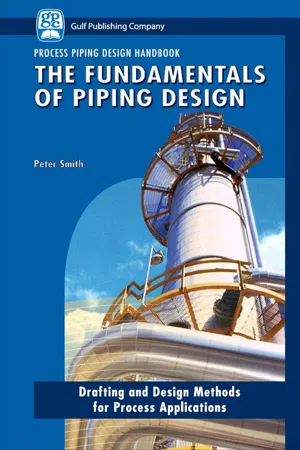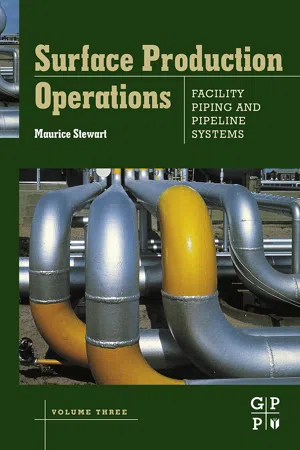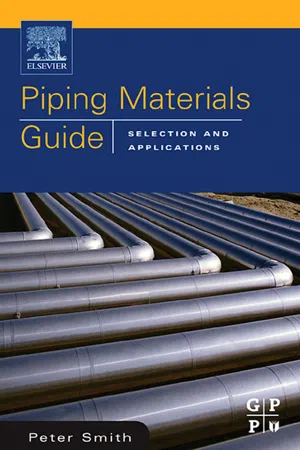Technology & Engineering
Piping
Piping refers to the system of pipes used to convey fluids from one location to another. It is a crucial component in various industries, including oil and gas, chemical processing, and water distribution. Piping systems are designed to transport liquids, gases, and solids, and they play a vital role in the infrastructure of many technological and engineering applications.
Written by Perlego with AI-assistance
6 Key excerpts on "Piping"
- eBook - ePub
- Peter Smith(Author)
- 2013(Publication Date)
- Gulf Publishing Company(Publisher)
Piping system. This chapter introduces the reader to these components and explains their design function and how they are specified, manufactured, and installed. All components have their own characteristics, both positive and negative, and it is essential to be aware of their strengths and weaknesses. Specifying them can become complex, especially for valves and Piping special items.The individual components necessary to complete a Piping system are• Pipe. • Piping fittings. • Valves. • Bolts and gaskets (fasteners and sealing). • Piping special items, such as steam traps, pipe supports, and valve interlocking.These pressure-containing and non-pressure-containing components combine to form the ingredients of a Piping system.I introduce each category and outline the general international standards and specifications that apply to that particular group of components. Although individual components have different commercial values and availability, all are of equal importance in a Piping system that is to function safely and efficiently (see Figure 2-1 ).Figure 2-1 A 3D model that shows a variety of components used to pipe up a vertical vessel. (Printed with the permission of Bentley Systems Incorporated.)For example, you could have a very expensive valve held in position by two, comparatively less expensive flanges, two gaskets, and a set of bolting worth a fraction of the cost but no less important. The specification and the correct installation procedure of mating flanges, gaskets, and bolts are essential for the valve to be installed and function efficiently within a Piping system.I start with the least complex component within a process Piping system.2.2 Pipe
Pipe is the main artery that connects the various pieces of process and utility equipment within a process plant. Although it can be considered to be the least complex component within a Piping system, it is not without its peculiarities. Pipe used within a process plant designed to one of the ASME B31 codes generally is of a metallic construction, such as carbon steel, stainless steel, duplex, copper, or to a lesser degree, one of the more exotic metals like Monel or titanium. - Maurice Stewart(Author)
- 2015(Publication Date)
- Gulf Professional Publishing(Publisher)
9Piping system design
Layout, supports, and Piping vessels and equipment
Abstract
Successful Piping systems require detailed planning. When the process design is complete, a process flow diagram is prepared. Ideally, the Piping and mechanical and instrumentation specialty engineers then design the equipment that will be used to prepare the Piping and instrumentation diagram (P&ID). Before the designer can choose materials that will provide safe, durable installation, he or she must first determine the applicable codes, standards, and recommended practices for construction. Equipment in a production facility must be properly located in order to minimize fire potential from venting and leaking combustible materials. Equipment orientation should allow for the maximum use of prevailing winds to enhance facility performance and provide protection of the environment against excessive pollution. Once the major equipment location is determined, the areas open to Piping are established.Vessels, heat exchangers, towers, aerial coolers, and fired heaters are the heart of the process facility. This chapter covers the many aspects that need to be considered when Piping this equipment. Specific topics such as pipe supports, liquid inlet Piping requirements, vessel drains, bypass valves, effects of threaded Piping, manholes and nozzles, and platforms and ladders are discussed.Machinery housing consists of cast iron or steel housings with forged steel in high stress components. Any bending or torsional moments caused by the Piping are applied directly to the housing. These loads may result in bearing and parts misalignment that will lead to excessive wear and eventual equipment failure. This chapter discusses the proper design of Piping configurations and types of connections that are necessary to avoid catastrophic failures.- eBook - ePub
- Andrè Garcia McDonald, Hugh Magande(Authors)
- 2012(Publication Date)
- Wiley(Publisher)
3 Liquid Piping Systems 3.1 Liquid Piping SystemsPiping systems are used to transport diverse liquids for a variety of different applications. These applications may range from water service for buildings to complex two-phase flow systems in industrial plants. The design of these systems requires consideration of several groups of specialties and accessories that will be needed for a functional system. This chapter will focus on fittings and accessories, pipe materials, fluid machines, and design considerations necessary for the successful design of practical Piping systems for various applications.3.2 Minor Losses: Fittings and Valves in Liquid Piping Systems 3.2.1 FittingsFittings are used to extend pipe lengths, expand the pipe network, or perform a selected function. Examples of fittings specific to liquid Piping systems are plugs, unions, wyes, valves, tees, caps, ferrules, elbows, nipples, reducers, sleeves, couplings, adapters, fasteners, compression fittings, and bulkhead fittings, to name a few. All these add resistance to fluid flow. Tabulated K values (loss coefficients) are available for these and other fittings.3.2.2 ValvesValves are used to control the flow rate of fluid in Piping systems. For valves, lower K values occur when they are fully open; thus, frictional losses will be low. The K values will increase as the valve is closed. A similar trend will apply to L equiv values. There are many types of valves. Some of these valves and their drawing symbols are shown in Figure 3.1 . Additional information and typical K values for valves are provided in Table A.14. Manufacturer's catalogs should be consulted to find other valves and/or pipe fittings and their K or L equiv values.3.2.3 A Typical Piping System—A Closed-Loop Fuel Oil Piping SystemFigure 3.1 Some typical industrial valvesThe schematic drawing shown in Figure 3.2 - eBook - ePub
- Peter Smith(Author)
- 2005(Publication Date)
- Gulf Professional Publishing(Publisher)
Process Piping systems are the arteries of a process plant. They receive the feedstock, carry the product through the various items of process equipment for treatment, and finally deliver the refined fluid to the battery limits for transportation to the next facility for further refinement. Process Piping systems can be further divided into primary process, which is the main process flow, and secondary process, which applies to the various recycling systems.Utility Piping systems are no less important. They are there to support the primary process, falling into three groups:• Support—instrument air, cooling water, steam. • Maintenance—plant air, nitrogen. • Protection—foam and firewater.There are other utility services such as drinking water.Piping Classes.
Each Piping system is allocated a Piping class, which lists all the components required to construct the Piping. A Piping class includes the following:• Process design conditions. • Corrosion allowance. • List of Piping components. • Branch table. • Special assemblies. • Support notes.Both process and utility Piping systems operate at various temperatures and pressures, and the following must be analyzed:• Fluid type—corrosivity, toxicity, viscosity. • Temperature range. • Pressure range. • Size range. • Method of joining. • Corrosion allowance.After analyzing these characteristics, process and utility Piping systems can be grouped into autonomous Piping classes. This allows Piping systems that share fundamental characteristics (pipe size range, pressure and temperature limits, and method of joining) to be classified together.This standardization or optimization has benefits in the procurement, inspection, and construction phases of the project. Too little optimization increases the number of Piping classes, making the paperwork at all stages of the project difficult to handle and leading to confusion, resulting in mistakes. Too much optimization reduces the number of Piping classes, however, as the Piping class must satisfy the characteristics of the most severe service and use the most expensive material. This means that less-severe services are constructed using more-expensive material, because the Piping class is “overspecified.” It is the responsibility of the Piping material engineer to fine-tune this optimization to the benefit the project. - eBook - ePub
- Ian Sutton(Author)
- 2017(Publication Date)
- Gulf Professional Publishing(Publisher)
Chapter 4Piping
Abstract
Piping is at the heart of any process facility and generally makes up a large fraction of the overall capital cost. This chapter describes the design, operation, and maintenance of Piping in energy and process facilities. Pipe fittings such as blinds, flanges, flame arrestors, heat tracing and vortex breakers are also discussed.Keywords
Piping; insulation; pipe specs; gaskets; blinds; spec blinds; flame arrestors; detonation arrestors; vortex breakers; flanges; bolts; Pipe sizing; Pipe schedule; Pipe materials; Underground Piping; Steam tracing; Electrical tracingIntroduction
Piping is at the heart of any process facility and generally makes up a large fraction of the overall capital cost. This chapter describes the design, operation, and maintenance of Piping in the energy and process facilities.Many of the comments made with respect to the safety and operation of pressure vessels in the previous chapter apply equally to Piping. Indeed, a pipe is, in effect, a long, narrow pressure vessel, although one that is more vulnerable to vibration, thermal expansion/contraction, and external impact from vehicles and projectiles.Regulations and Standards
There are many codes and standards to do with process Piping, as shown in Table 4.1 . Those from the American Society of Mechanical Engineers (ASME) and the American National Standards Institute (ANSI) are particularly important. They provide guidelines that standardize sizing, design formulas, and safety restrictions.Table 4.1 Regulations and Standards for PipingNumber Title Comments Piping ANSI B16.5 Pipe Flanges and Flanged Fittings Covers pressure–temperature ratings, materials, dimensions, tolerances, marking, testing, and methods of designating openings for pipe flanges and flanged fittings. Included are flanges with rating class designations 150, 300, 400, 600, 900, and 1500 in sizes NPS 1/2 through NPS 24. ANSI B16.47 is used for larger pipe diameters. - eBook - ePub
Oil and Gas Pipelines and Piping Systems
Design, Construction, Management, and Inspection
- Alireza Bahadori(Author)
- 2016(Publication Date)
- Gulf Professional Publishing(Publisher)
Chapter 13Engineering Aspects for Plant Piping Systems
Abstract
This chapter covers essential requirements for general aspects to be considered in the design of Piping for oil, gas, and petrochemical plants that include, but are not limited to, the following: loading and unloading terminals, crude oil- and gas-gathering central facilities, process units, package equipment, pump house, and compressor stations (booster stations), tank farms, and oil/gas depots.Keywords
General plot plan; unit plot plan; layout; Piping systemIntroduction
This covers the minimum requirements for Design of Plant Piping Systems to be used in oil, gas, and petrochemical industries. The Standard is based on ASME B31.3. The chapter consists of the following parts:Part 1—General Design Requirements Part 2—Above-Ground Piping SystemsPart 3—Underground Piping SystemsThis chapter covers minimum requirement(s) for general aspects to be considered in design of Piping for oil, gas, and petrochemical plants to be designed in accordance with ASME B31.3. These requirements include, but are not limited to, the following:
Index pages curate the most relevant extracts from our library of academic textbooks. They’ve been created using an in-house natural language model (NLM), each adding context and meaning to key research topics.
Explore more topic indexes
Explore more topic indexes
1 of 6
Explore more topic indexes
1 of 4





